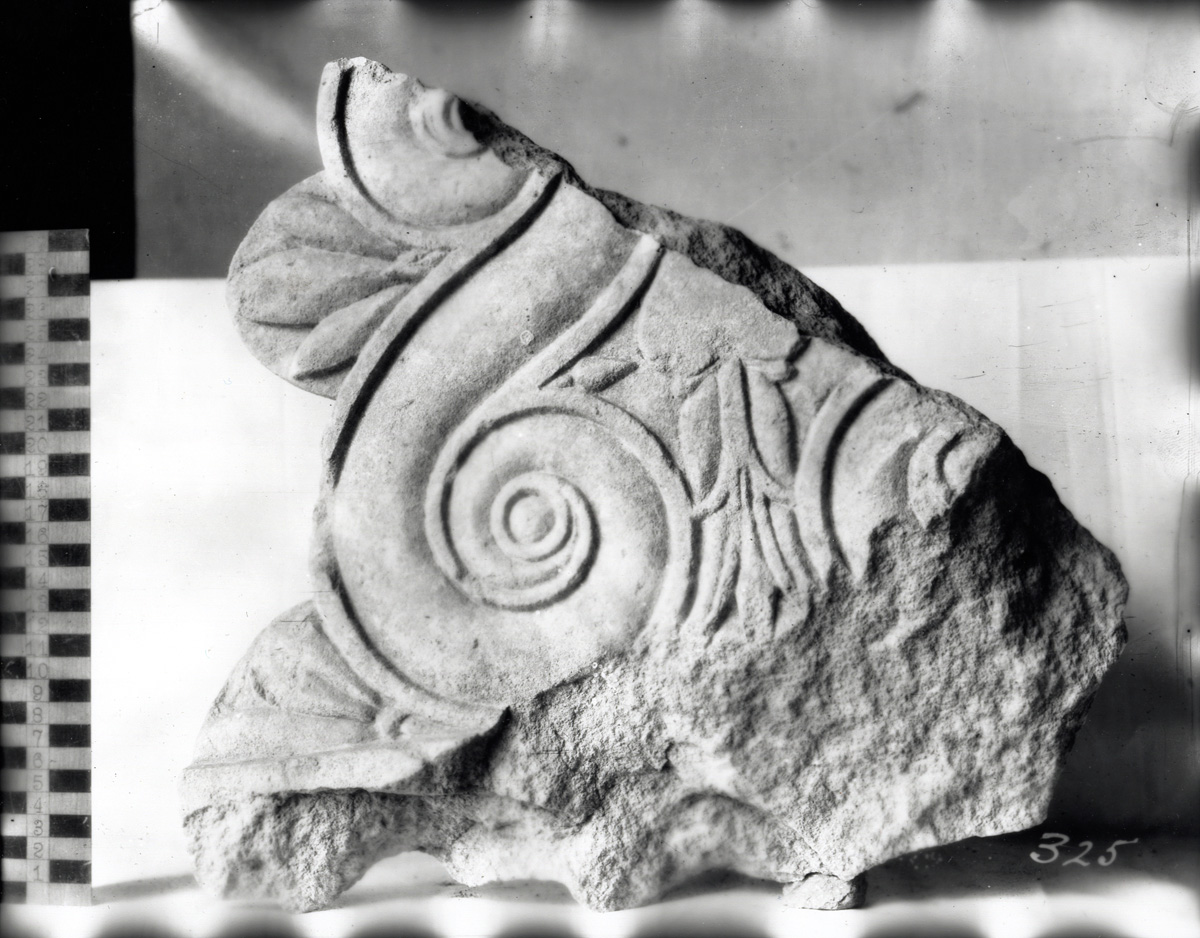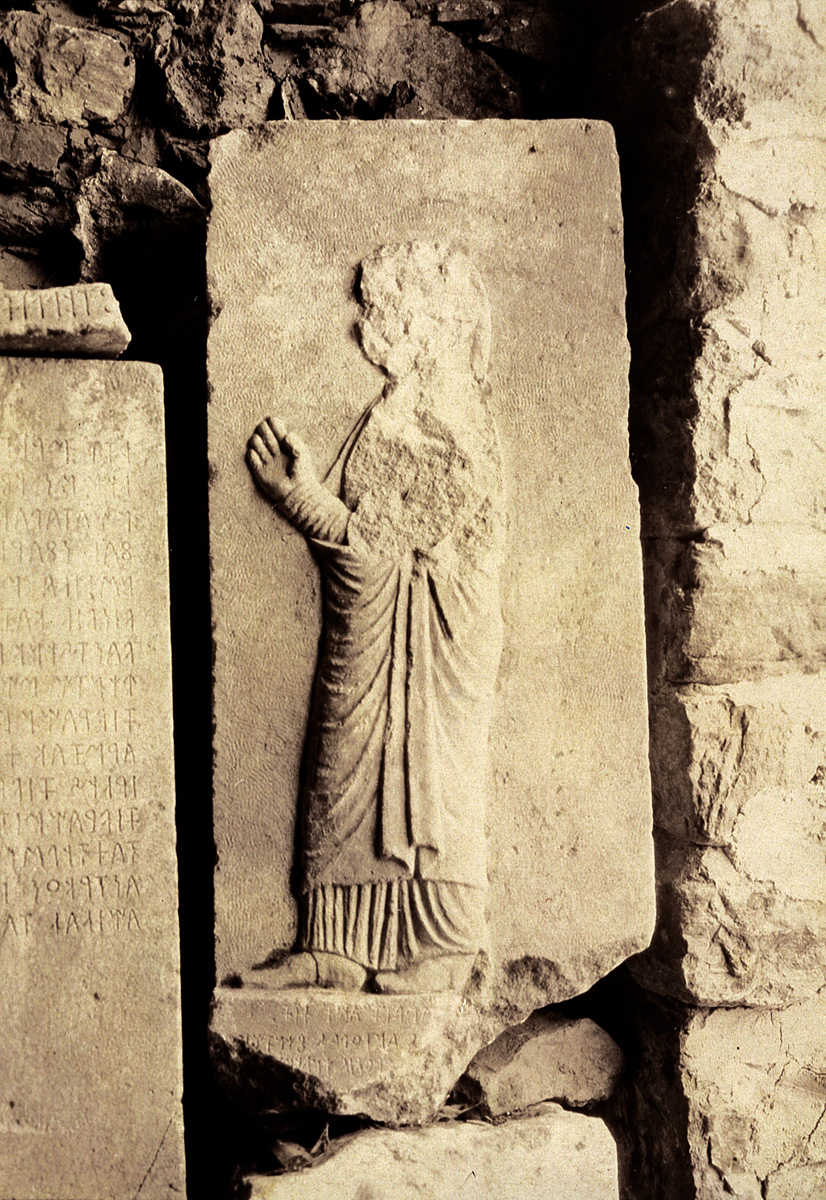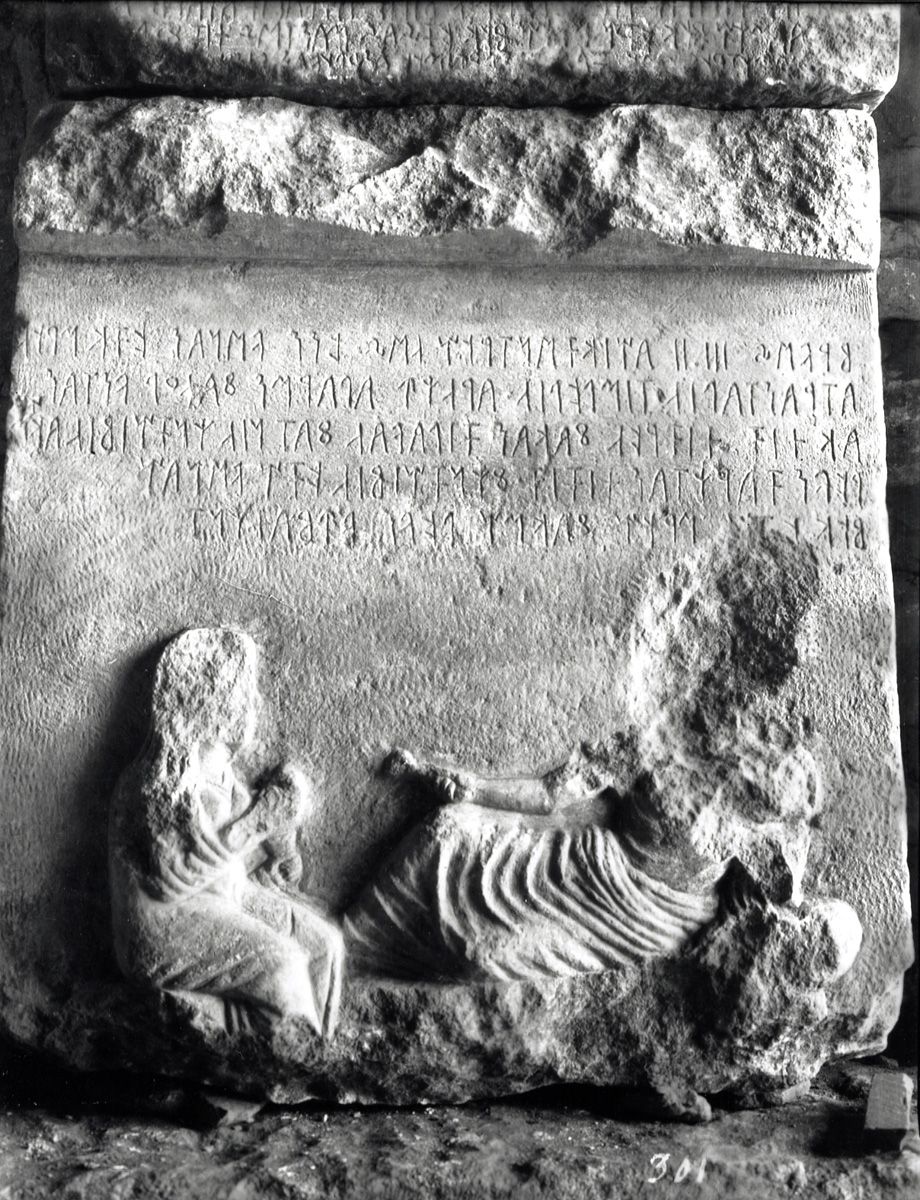-
 Marble Stele of Atrastas
Marble Stele of AtrastasLATW Cat. 10
Sculpture, Inscription
Marble, Stone
520-500 BC (Hanfmann); 4th c BC (Bossert) (Late Lydian (Persian))
Stele of white marble. Above, relief showing a man seated on a stool at a table, behind him an indistinct form that has been variously identified (standing child, Bossert; foreparts of a dog, Hanfmann). The man either has a disproportionately long ri...
-
 Grave Stele from Haliller
Grave Stele from HalillerLATW Cat. 11
Sculpture, Inscription
Marble, Stone
Shortly after the middle of the 4th c BC (Late Lydian (Persian))
At the top of the stele, “a local version of an anthemion finial of lyre-volute type. In place of the usual palmette is a schematic rendering of a bird in flight, with splayed wing feathers substituting for palmette leaves” (Roosevelt 2009, 261). Bel...
-
 Marble Votive Stele Showing Artemis and Cybele
Marble Votive Stele Showing Artemis and CybeleLATW Cat. 35
Sculpture
Marble, Stone
Ca. 400 BC (Late Lydian (Persian))
White marble. Rectangular stele missing top. Raised borders representing the steps, antae, and pediment of a temple or naiskos frame, four figures in relief. Occupying more than two-thirds of the framed space at left and center are two female figures...
-
 Inscribed Stele with Relief: Monument for Nympheros, a gladiator
Inscribed Stele with Relief: Monument for Nympheros, a gladiatorM14 Cat. 412
Sculpture, Inscription
Marble, Stone
“2nd century AD” (Hanfmann and Ramage). (Roman)
Stele of white marble, with semicircular top. The relief shows a nude athlete (a gladiator?), who holds a weight(?) in his right hand and a javelin in his left. Additional objects represented include a hoe and a pair of cylinders held suspended by a ...
-
![Inscribed Stele with Relief: Monument for [- -]los, a gladiator](https://omphale.arthistory.wisc.edu/1975/75.046.17.jpg) Inscribed Stele with Relief: Monument for [- -]los, a gladiator
Inscribed Stele with Relief: Monument for [- -]los, a gladiatorM14 Cat. 413
Sculpture, Inscription
Marble, Stone
“3rd century A.D.?” (Hanfmann and Ramage, R2). (Roman)
The name Nympheros is attested for gladiators; see L. Robert, Gladiateurs, nos. 191a, 300, 302, and p. 301; also SEG 38, 589. Stele fragment of white marble. The relief shows a heavily armed gladiator with helmet and shield striding toward the right;...
-
 Inscribed Stele with Seated Man (Atrastas, son of Sakardas)
Inscribed Stele with Seated Man (Atrastas, son of Sakardas)R2 Cat. 17
Sculpture
Marble, Stone
520-500 BC (Late Lydian (Persian))
The stele was set at the bottom into a base. The back, which was probably not seen, is extremely roughly trimmed. The sides are finished with multiple claw chisel. The lower part of the front preserves the scattered stroke patterns of claw chisel and...
-
 Fragment of Anthemion
Fragment of AnthemionR2 Cat. 46
Sculpture
Marble, Stone
530-520 BC (Late Lydian (Persian))
Fragment of a stele with lotus-volute finial (anthemion).The general type is made clear by the stele Cat. 45 (Figs. 148-149; and a closely comparable fragment from Daskylion (Fig. 152). Preserved is the central part of the finial and the broad raised...
-
 Chamber Tomb Stele
Chamber Tomb SteleR2 Cat. 47
Sculpture
Limestone, Stone
520-480 BC (Late Lydian (Persian))
The plain shaft rises from a simple low rectangular base. The proportion of shaft H. to W. is 4:1. Unlike Cat. 45 and Cat. 46 (Figs. 148-151) the convex volutes rose from two central stems; the eye was an elaborate plastic rosette. A thin, "mannerist...
-
 Fragment of Anthemion
Fragment of AnthemionR2 Cat. 48
Sculpture
Marble, Stone
500-450 BC (Late Lydian (Persian))
The finial consisted of two spirals symmetrically placed in lyre-like design. H.C. Butler writes, "The two double reversed scrolls carried some crowning feature like a palmette. The scrolls were described by pulvinated bands with raised flat edges. T...
-
 Anthemion Stele Fragment with Lydian Inscription
Anthemion Stele Fragment with Lydian InscriptionR2 Cat. 49
Sculpture
Marble, Stone
Later 5th or 4th C. BC? (Late Lydian (Persian)?)
The carefully cut ornament includes part of a downward-pointed lotus with five thin leaves, a concave leaf-like ending to the lower part of a volute, and a rounded part above. The finial projected sideways from the shaft. The leaf-like volute end con...
-
 Stele with Praying Woman
Stele with Praying WomanR2 Cat. 233
Sculpture
Marble, Stone
450-425 BC (Late Lydian (Persian))
Although there is no sign of dowelling on top, the stele probably had a covering element, possibly a palmette. A female figure facing to I. is placed freely and somewhat asymmetrically on a claw-chiseled background. The sides of the stele are also cl...
-
 Funerary Stele of Atrastas, son of Timles
Funerary Stele of Atrastas, son of TimlesR2 Cat. 234
Sculpture
Marble, Stone
330-329 BC (Hellenistic)
C. H. Greenewalt, Jr. noted that at the top, the relief molding has painted egg and dart motif, yellow with black background. There are five lines of text in Lydian, with red preserved in some letters. Below the text is a sculptured scene showing a m...